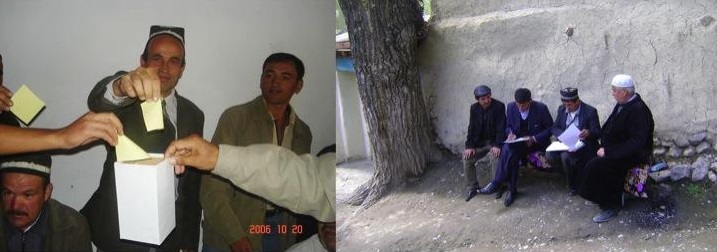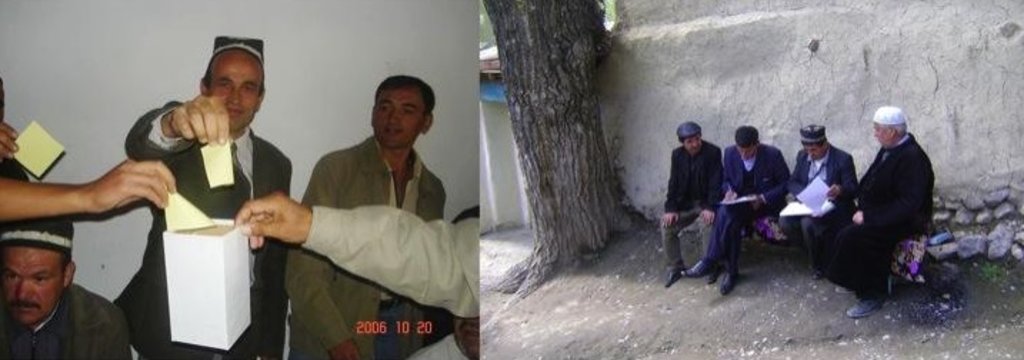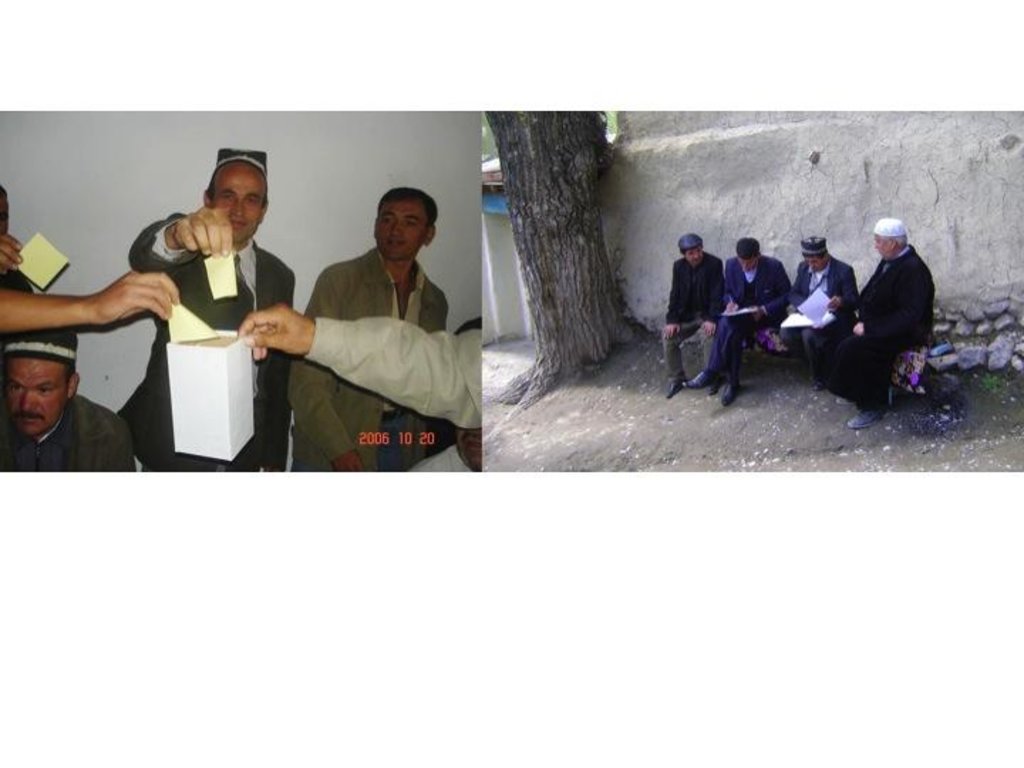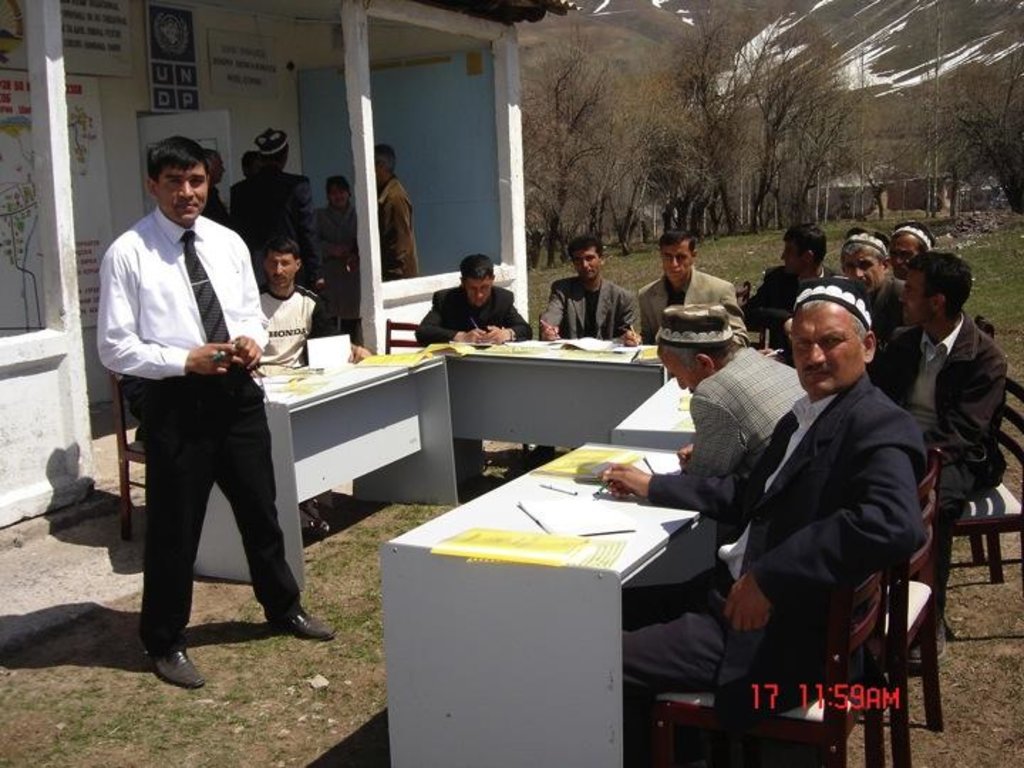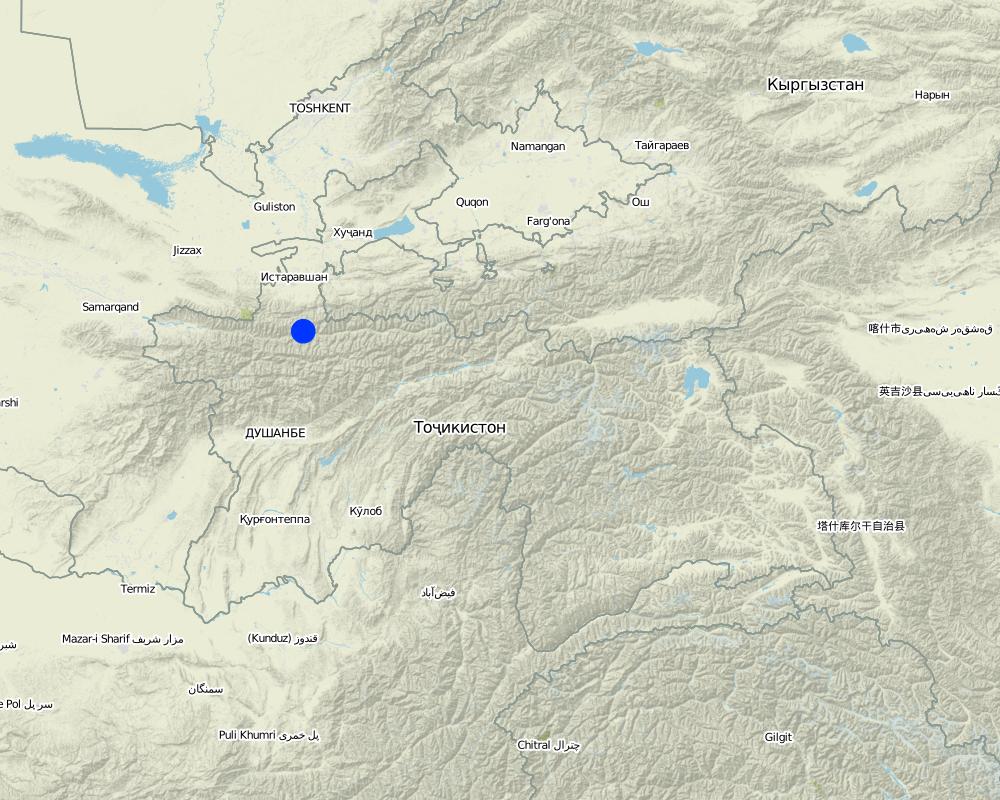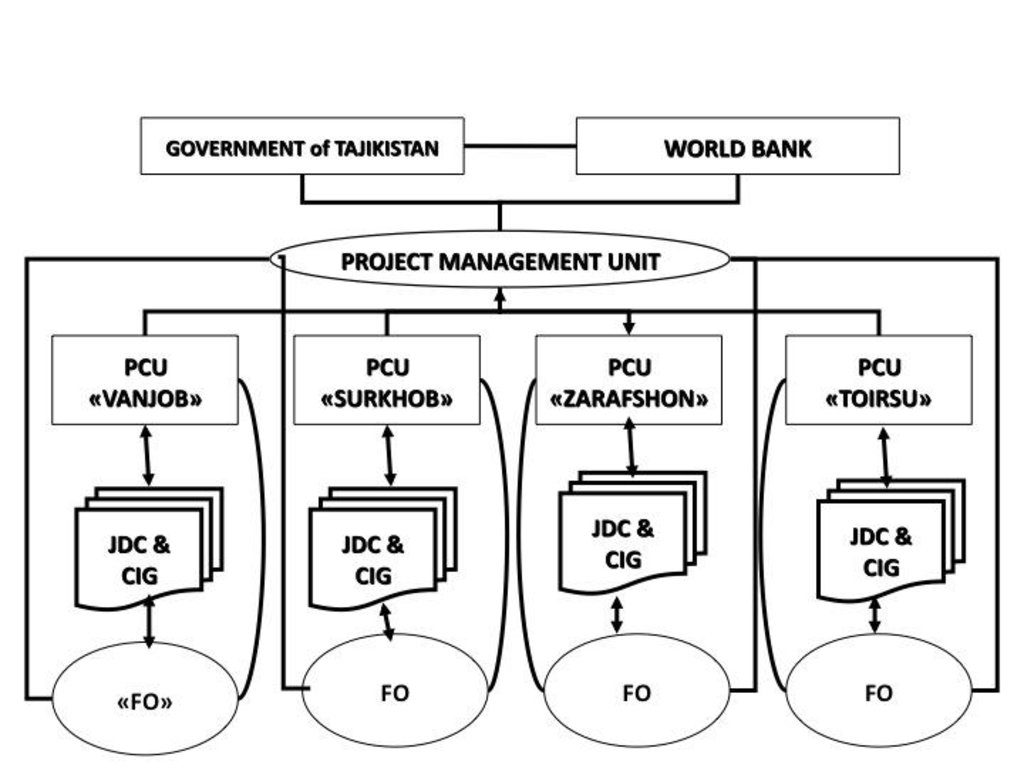Sub-district (Jamoat) level support for sustainable land management [Тажикистан]
- Шинийг нээх:
- Шинэчлэх:
- Эмхэтгэгч: Nandita Jain
- Хянан тохиолдуулагч: –
- Хянагчид: David Streiff, Alexandra Gavilano
approaches_2446 - Тажикистан
Бүлгүүдийг үзэх
Бүгдийг дэлгэх Бүгдийг хаах1. Ерөнхий мэдээлэл
1.2 Арга барилыг баримтжуулах болон үнэлгээ хийхэд оролцсон хүн эсвэл байгууллагын холбоо барих хаяг
ГТМ мэргэжилтэн:
Mott Jessica
World Bank
Америк
Арга барилыг баримтжуулах/үнэлэх ажилд дэмжлэг үзүүлсэн байгууллага(ууд)-ын нэр (шаардлагатай бол)
World Bank (World Bank) - Америк1.3 WOCAT-аар баримтжуулсан өгөгдлийг ашиглахтай холбоотой нөхцөл
Мэдээллийг хэзээ (газар дээр нь) цуглуулсан бэ?
20/10/2006
Эмхэтгэгч болон гол мэдээлэгч хүн(хүмүүс) WOCAT аргачлалаар баримтжуулсан мэдээллийг ашиглахтай холбоотой нөхцлийг хүлээн зөвшөөрсөн:
Тийм
2. ГТМ Арга барилын тодорхойлолт
2.1 Арга барилын товч тодорхойлолт
Provision of technical and financial management assistance through Jamoat (“Sub-District”) level organizations to farmers in a large small grants programme.
2.2 Арга барилын дэлгэрэнгүй тодорхойлолт
Арга барилын дэлгэрэнгүй тодорхойлолт:
Aims / objectives: The Tajikistan - Community Agriculture & Watershed Management Project (CAWMP), aimed to use a sub-district level organization to provide more efficient, transparent and accountable services to farmers for the project duration. CAWMP financed small grants to farmer groups for agricultural production in environmentally sustainable ways in Tajikistan’s uplands. The sub-district level support for this initial six year period, together with support from other project partners, helped (a) enable project implementation, and (b) build farmer capacity to sustain the investments after the end of six-year project, even in the absence of continued outside support.
Methods: In four project sites 39 Jamoat (“sub-district”) Development Committees (JDCs) operated as NGOs with elected officers and helped organize 43,000 households into groups to implement 4,000 rural production investments that included varied SLM technologies in 402 villages. JDCs managed $7.4 million in small grants. Use of the JDC built upon existing initiatives to strengthen local governance. The JDCs collaborated and received support from a government-appointed Project Management Unit (PMU), field-based Project Coordination Units (PCUs), and four contracted Facilitating Organizations (FOs). These partners helped train JDCs in financial, organizational, and technical aspects (e.g. fund flow, participatory planning, SLM technologies), and assisted villages to form new JDCs where none existed.
Stages of implementation: JDCs, with FOs and PCU specialists, undertook activities including: 1) preparation of participatory village-based Community Action Plans (CAPs) that included proposed rural production investments and formation of Common Interest Groups (CIGs) of households [See TAJ046}; 2) participation in sub-district and project-site/watershed level screening and approval of rural production proposals from CIGs to ensure economic, environmental and social feasibility [See TAJ045]; 3) management and disbursement of grant funds from the PMU to CIGs [See TAJ 044]; 4) overseeing formal investment agreements with participating CIGs; 5) monitoring, evaluation and reporting; and 6) liaison with other villages and relevant government agencies to facilitate permissions, resource use agreements, issuance of land use rights, etc.
Role of stakeholders: JDCs comprised elected village representatives and the government’s sub-district officials. Generally, JDC members have relatively higher levels of education and relevant knowledge and experience than the local population. A JDC chairperson and secretary were elected and a qualified accountant/bookkeeper appointed. JDCs met monthly and established committees, (e.g., gender, environment, financial management and social). CAWMP paid an honorarium for the accountant and incremental travel costs for all JDCs. For newly established JDCs, CAWMP also provided funds for office facilities, plus an honorarium for the chairperson, and an additional honorarium for another officer if one was female.
2.3 Арга барилын зурагууд
2.5 Арга барил нэвтрүүлсэн улс орон / бүс нутаг / байршил
Улс:
Тажикистан
Улс/аймаг/сум:
Sughd, Khatlon, RSS, GBAO
Байршлын дэлгэрэнгүй тодорхойлолт:
7 districts and 39 sub-districts
Тайлбар:
As part of the Commnunity Agriculture and Watershed Management Project, the approach was implemented in Jirgital, Tajikibad, Vanj, Aini, Matcha, Penjikent, Danghara districts, in 4 regions. Four project sites/watersheds - Surkhob, Vanjob, Zarafshan and Toirsu - were included in the The total catchment area was 35,000km2. Total arable, farm and pasture land was approximately 319,500ha
Map
×2.6 Арга барилыг эхлэх, дуусах огноо
Эхлэх жилийг тэмдэглэ:
2005
Хугацаа дуусах жил (Хэрэв арга барил удаанаар ашиглаагүй бол):
2012
2.7 Арга барилын төрөл
- төсөл / хөтөлбөр дээр үндэслэсэн
2.8 Арга барилын үндсэн зорилго, зорилтууд
The Approach focused mainly on other activities than SLM (Sub-district assistance, non-government organizations, farmer groups, facilitation support, technical advice, fund transfers to farmer groups, )
Efficient and responsible sub-district institutional arrangements for a fixed-term project that are able to assist upland farmers in adopting practices to increase agricultural production in sustainable ways.
The SLM Approach addressed the following problems: Use of sub-district organizations provided an efficient, transparent and accountable way of providing essential services to farmers for the period of initial investment, i.e., the six-year period of project implementation. Alternatives ways of providing this support would have had disadvantages: such support at a village level would have been too expensive and faced human capacity constraints, while using the centralized government system or relying solely on large NGOs would have been less transparent, less participatory, and less accountable to the interests of local people.
2.9 Арга барилын хүрээнд хэрэгжсэн Технологи/Технологиудад дэмжсэн эсвэл саад учруулсан нөхцлүүд
санхүүгийн нөөц, үйлчилгээний хүртээмж / боломж
- Хазаарлалт
Poor transparency and accountability in financial transactions between government and farmers in rural development. Upland farmers lacked financial capital.
Treatment through the SLM Approach: JDC support services for managing about 4000 small grants, including participatory planning and streamlined fund transfers from PMU to farmer groups through JDCs.
Бүтэц зохион байгуулалт
- Хазаарлалт
Limited financial and technical resources for upland agriculture given government focus on lowland crop, especially cotton, production. Remoteness restricts access to available services.
Treatment through the SLM Approach: Access to technical and financial services through establishment and capacity building of 39 JDCs in upland areas.
Хууль, эрхзүйн хүрээ (газар эзэмшил, газар, ус ашиглах эрх)
- Хазаарлалт
Slow issuance of land use rights certificates for upland family farms - poor incentives to invest household assets and adopt SLM practices. No rights allocation for horticulture, woodlots and other uses with restricted access on sloping lands.
Treatment through the SLM Approach: Legal agreements governing CAWMP permitted issuance of certificates (including for sloping lands) to project participants on the basis of adopting SLM practices.
The existing land ownership, land use rights / water rights hindered a little the approach implementation Very few Land Use Rights Certificates had been issued at start of project for arable land in upland areas. There was no provision for allocation of use rights to non-arable sloping lands suitable for horticulture, woodlots and other restricted access uses.
ГТМ-ийн талаарх мэдлэг, техникийн дэмжлэг авах боломж
- Хазаарлалт
Lack of technical capacity among farmers in participatory processes and SLM technologies and methods.
Treatment through the SLM Approach: Extensive training for JDCs in order to assist farmers. Trainings for local government specialists to facilitate local approvals for CIG activities.
3. Оролцогч талуудын оролцоо ба үүргүүд
3.1 Арга барилд оролцогч талууд болон тэдгээрийн үүргүүд
- Орон нутгийн газар ашиглагч / орон нутгийн иргэд
JDCs registered as non-profit, non-government organisations
Most JDCs had women members, but overall levels of female participation were less than 25%. Social and cultural circumstances, especially in the more remote upland areas, place restrictions on the extent to which women can actively participate in organisations such as JDCs. Among the four project sites, there were also differences in the number of women represented in JDCs
There was some representation in JDCs of poor, vulnerable households, as well as single female-headed households
- ТББ
International NGOs: Welthungerhilfe, Aga Khan Foundation/Mountain Societies Development Support Programme
- Засгийн газар (шийдвэр гаргагч, төлөвлөгч)
Project Management Unit, Project Coordination Units
- Олон улсын байгууллага
UNDP-Tajikistan, FAO-Tajikistan
3.2 Арга барилын янз бүрийн үе шатанд орон нутгийн газар ашиглагчид / бүлэглэлүүдийг татан оролцуулах
| Орон нутгийн газар ашиглагч / орон нутгийн иргэдийн оролцоо | Хэн оролцсоныг тодорхойлж, үйл ажиллагааг тайлбарлана уу | |
|---|---|---|
| санаачлага/идэвхжүүлэлт | үгүй | |
| Төлөвлөгөө | идэвхигүй | Local communities consulted for social assessment during project design. |
| Хэрэгжилт | интерактив | JDC members (village representatives) provided a range of services to villagers and other functions such as liaison with government for the purposes of CAWMP. |
| Мониторинг/ үнэлгээ | интерактив | JDCs and CIGs were signatories of formal agreements governing grants for rural production. JDCs released funds based on agreed benchmarks and with PCUs and FOs monitored and reported on environmental, economic and social aspects. |
| Research | үгүй |
3.3 Диаграм (хэрэв боломжтой бол)
Тодорхойлолт:
Implementation Arrangements for Community Agriculture and Watershed Management Project
Зохиогч:
Project Management Unit (Dushanbe, Tajikistan)
3.4 ГТМ-ийн технологи/технологиуд сонгох шийдвэр
Хэрэгжүүлэх Технологи/Технологиудын сонголтыг хийж шийдвэр гаргасан хүнийг тодорхойлно уу:
- ГТМ-ийн мэргэжилтнүүдийн дэмжлэгтэйгээр, голчлон газар ашиглагчид
Тайлбар:
CIG members and technical specialists made decisions on the choice of SLM technologies in any one small grant proposal. Within each JDC, the entire committee made decisions on acceptable proposals, with a technical committee often conducting the initial screening. On obtaining JDC approval, proposals were submitted for further review by a regional Watershed Devlelopment Committee
Decisions on the method of implementing the SLM Technology were made by mainly by land users supported by SLM specialists. CIG members and technical specialists from the respective facilitating organisation and the project coordination unit made decisions on the method/s for implementing SLM technologies in any one proposal. However, CIGs undertook full responsibility for the implementation and management of the rural production investments.
4. Техникийн дэмжлэг, чадавхи бүрдүүлэх, мэдлэгийн менежмент
4.1 Чадавхи бэхжүүлэх/сургалт
Газар эзэмшигчид / бусад оролцогч талуудад сургалт явуулсан уу?
Тийм
Хэн сургалтанд хамрагдсан бэ:
- Газар ашиглагчид
- хээрийн ажилтан / зөвлөх
- JDCs
Сургалтын хэлбэр:
- Ажил дээр
- фермерээс -фермер
- үзүүлэнгийн талбай
- Олон нийтийн уулзалт
Хамрагдсан сэвдүүд:
Organisational Management, Book-keeping, Participatory rural appraisal, Participatory environmental planning and analysis, a range of SLM technologies, monitoring and evaluation, gender awareness.
4.2 Зөвлөх үйлчилгээ
Газар ашиглагчдад зөвлөх үйлчилгээ авах боломжтой байдаг уу?
Тийм
- informal information
Тодорхойлолт / тайлбар:
Informal advice and facilitation support by JDCs, in collaboration with other project partners: Key elements: Project design and procedures, Technical, financial and institutional considerations of proposed investments for grant financing, fostering increased knowledge and changes in attitudes and practices among farmers to identify advice needed, and for ongoing learning during the post project period.;
Nominal government advisory services exist at district level, and even less in sub-districts. Technical capacities for SLM are lacking. Staff are poorly paid, positions are unfilled and finances are inadequate. Little orientation toward client service and governance problems are common. Conditions unlikely to change in foreseeable future. JDCs and project partners provided informal advisory services during investment period, created demand among farmers to seek advice in post-project period.
See comments in 2.4.2.1. for information on government advisory services
4.3 Институцийг бэхжүүлэх (байгууллагын хөгжил)
Арга барилаар дамжуулан институц байгуулагдаж эсвэл бэхжсэн үү?
- Тийм, маш их
Байгууллагууд бэхжиж, үүсэн бий болсон түвшин(үүд)-г тодорхойлно уу:
- Орон нутгийн
Дэмжлэгийн төрлийг ялга:
- Санхүүгийн
- чадавхи бэхжүүлэх / сургалт
- Тоног төхөөрөмж
Дэлгэрэнгүй мэдээллийг өгнө үү:
Support of sub-district local institutions is the focus of the Approach.
4.4 Мониторинг ба үнэлгээ
Мониторинг болон үнэлгээ нь арга барилын хэсэг үү?
Тийм
Тайлбар:
management of Approach aspects were None monitored by project staff through observations; indicators: Quality of CIG proposals and implementation, rate of fund disbursement to CIGs, timeliness of report
There were few changes in the Approach as a result of monitoring and evaluation: Poor initial attention to environmental aspects of SLM and other investments in CIG proposals led to increased training for JDCs, FOs, PMU, PCU and local government officials in participatory environmental analysis.
There were few changes in the Technology as a result of monitoring and evaluation: Based on field observations and measurements in some cases, CIGs with the assistance of JDCs, FOs and project staff adjusted various SLM technologies that had been implemented as part of rural production investments during the course of implementation, e.g., composting procedures, irrigation techniques.
4.5 Судалгаа
Судалгаа арга барилын хэсэг нь байсан уу?
Тийм
- Project evaluations
Дэлгэрэнгүй мэдээллийг өгч, хэн судалгаа явуулсныг бичнэ үү:
While the JDCs did not directly carry out formal research, they participated as respondents in the project evaluations that were carried out by the NGOs, and the PMU. These evaluations included findings from a variety of stakeholder perspectives about the JDC involvement.
5. Санхүүгийн болон гадаад материаллаг дэмжлэг
5.1 ГТМ-ийн Арга барилын бүрэлдэхүүн хэсгийн жилийн төсөв
Хэрэв жилийн төсөв тодорхойгүй бол хягаарыг тодруулна уу:
- > 1,000,000
Тайлбар (жнь: санхүүжилтийн гол эх үүсвэр / гол хандивлагчид):
Approach costs were met by the following donors: local government (district, county, municipality, village etc) (Opportunity cost of government officials’ time): 5.0%; international non-government (Estimate of co-financing ): 5.0%; government (Estimate of co-financing ): 90.0%; international (World Bank/International Development Assistance and Global Environment Facility); local community / land user(s) (Opportunity cost of land users’ time); other (Opportunity cost of JDC members’ time )
5.2 Газар ашиглагчдад санхүүгийн / материаллаг дэмжлэг үзүүлсэн
Технологи / технологийг хэрэгжүүлэхэд газар ашиглагчид санхүүгийн / материаллаг дэмжлэг авсан уу?
Үгүй
5.4 Кредит
Арга барилын хүрээнд ГТМ-ийн үйл ажиллагаанд зориулж зээлд хамрагдсан уу?
Үгүй
6. Нөлөөллийн дүн шинжилгээ ба дүгнэлт
6.1 Арга барилын нөлөөллүүд
Арга барил нь ГТМ-ийн технологийг хэрэгжүүлж, хадгалахад газар ашиглагчдад тусласан уу?
- Үгүй
- Тийм, бага зэрэг
- Тийм, зарим
- Тийм, их
Providing sub-district-level support was critical for implementing almost 4000 rural production investments that integrated SLM practices into the management of over 96,000ha.
Арга барил нь эмзэг бүлгийнхнийг нийгэм, эдийн засгийн хувьд чадавхижуулсан уу?
- Үгүй
- Тийм, бага зэрэг
- Тийм, зарим
- Тийм, их
JDCs helped target vulnerable groups during community mobilization and preparation of CAPs. Women comprised 40% of project participants benefiting from rural production investments.
Арга барил нь ГТМ-ийн технологийг хэрэгжүүлэхэд саад учруулсан газрын эзэмшил / ашиглах эрхийг сайжруулахад чиглэсэн үү?
- Үгүй
- Тийм, бага зэрэг
- Тийм, зарим
- Тийм, их
Legal agreement for CAWMP permitted issuance of use rights certificates for sloping lands for horticulture, woodlots and other restricted access uses based on adoption of SLM practices. JDCs assisted project staff in processing certificates for participating households, linking farmers, project staff and government officials. Another project accelerated issuance of arable land certificates.
Did other land users / projects adopt the Approach?
- Үгүй
- Тийм, бага зэрэг
- Тийм, зарим
- Тийм, их
JDCs existed prior to the project, and CAWMP built upon this arrangement. Institutions similar to JDCs continue to be supported in some regions of the country. However, in accordance with the CAWMP design and the initial risk assessment, land users who have received CAMWP-financed grants are not necessarily dependent on the sustainability of JDC support during the post project period. These farmers should have the capacity, incentives, and the responsibility to sustain their investments.
Did the Approach lead to improved livelihoods / human well-being?
- Үгүй
- Тийм, бага зэрэг
- Тийм, зарим
- Тийм, их
An overall project assessment indicates that about 80% of investments implemented with the support of JDCs and other project partners, and in conjunction with other project activities are successful.
Did the Approach help to alleviate poverty?
- Үгүй
- Тийм, бага зэрэг
- Тийм, зарим
- Тийм, их
As part of the CAWMP, the approach contributed to increasing the proportion of people above poverty from 3% to 20% in the participating villages (to be updated with 2011 evaluation data).
6.2 ГТМ-ийг хэрэгжүүлэх газар ашиглагчидын гол санаачилга
- үйлдвэрлэл нэмэгдсэн
potentially more sustainable production
- Сүлжээ/ бүлэг төсөл/ хөдөлгөөнд гишүүнээр элсүүлэх
availability of investment capital, technical assistance
- well-being and livelihoods improvement
opportunity to increase livelihood assets
6.3 Арга барилын үйл ажиллагааны тогтвортой байдал
Газар ашиглагчид арга барилаар дамжуулан хэрэгжүүлсэн арга хэмжээг тогтвортой хадгалж чадах уу (гадны дэмжлэггүйгээр)?
- Тийм
Хэрэв тийм бол яаж гэдгийг тайлбарлана уу:
In accordance with the CAWMP design and the initial risk assessment, land users who have received CAMWP-financed grants are not necessarily dependent on the sustainability of JDC support during the post project period. These farmers should have the capacity, incentives, and the responsibility to sustain their investments on their own during the post-project period.
6.4 Арга барилын тогтвортой/давуу тал/боломжууд
| Газар ашиглагчдын тодорхойлсон давуу тал/боломжууд |
|---|
| To be added based on project evaluation due in late 2011 |
| Эмхэтгэгч, бусад мэдээлэл өгсөн хүмүүсийн өнцгөөс тодорхойлсон давуу тал/боломжууд |
|---|
| Scale and scope of JDC mandates is effective for delivering services to upland, and often remote, farmers. (How to sustain/ enhance this strength: Maintain a focus on strengthening sub-district level support to farmers.) |
| Sub-district level organisations can be an effective component of scaling-up strategies for SLM in a challenging physical landscape. (How to sustain/ enhance this strength: Scaling-up strategies will require investment in institutional arrangements.) |
| Participatory processes help ensure that organisations such as JDCs can work effectively with government units to deliver technical and financial resources to farmers. (How to sustain/ enhance this strength: Ensure that participatory processes, including financial management mechanisms, are well integrated into SLM programmes.) |
6.5 Арга барилын дутагдалтай/сул тал/аюул болон тэдгээрийн хэрхэн даван туулах арга замууд
| Эмхэтгэгч, бусад мэдээлэл өгсөн хүмүүсийн өнцгөөс тодорхойлсон сул тал/ дутагдал/ эрсдэл | Тэдгээрийг хэрхэн даван туулах вэ? |
|---|---|
| Uncertain financial sustainability of JDCs during the post-project period in the absence of donor funding. | 1. Continue to emphasize the importance of farmers having the capacity, incentives, and the responsibility to sustain their investments on their own, in the event that ongoing support from JDC is not available post-project. 2. Until more sustainable jamoat-level support system is established and proven to be effective in Tajikistan (i.e., meeting transparent, accountable, efficient, and capacity requirements), clarify fixed term nature of JDC support in order to avoid misunderstandings and unrealistic expectations. 3. Highlight JDC functions for the fixed term (6 years) under CAWMP and explore opportunities to include similar functions in current efforts of other donors to establish sub-district representative government bodies. |
7. Суурь мэдээлэл болон холбоосууд
7.2 Холбогдох бүтээлийн ишлэл
Гарчиг, зохиогч, он, ISBN:
Operational Manual for Community Mobilization, Rural Production Investments and Research and Demonstrations Grants (2008)
Гарчиг, зохиогч, он, ISBN:
Operational Manuals for JDCs and CIGs in Financial Management and Procurement (2007)
Гарчиг, зохиогч, он, ISBN:
CAWMP: Project Appraisal Document (2005)
Холбоос ба модулууд
Бүгдийг дэлгэх Бүгдийг хаахХолбоосууд
Холбоос байхгүй байна
Модулууд
Модуль байхгүй байна


